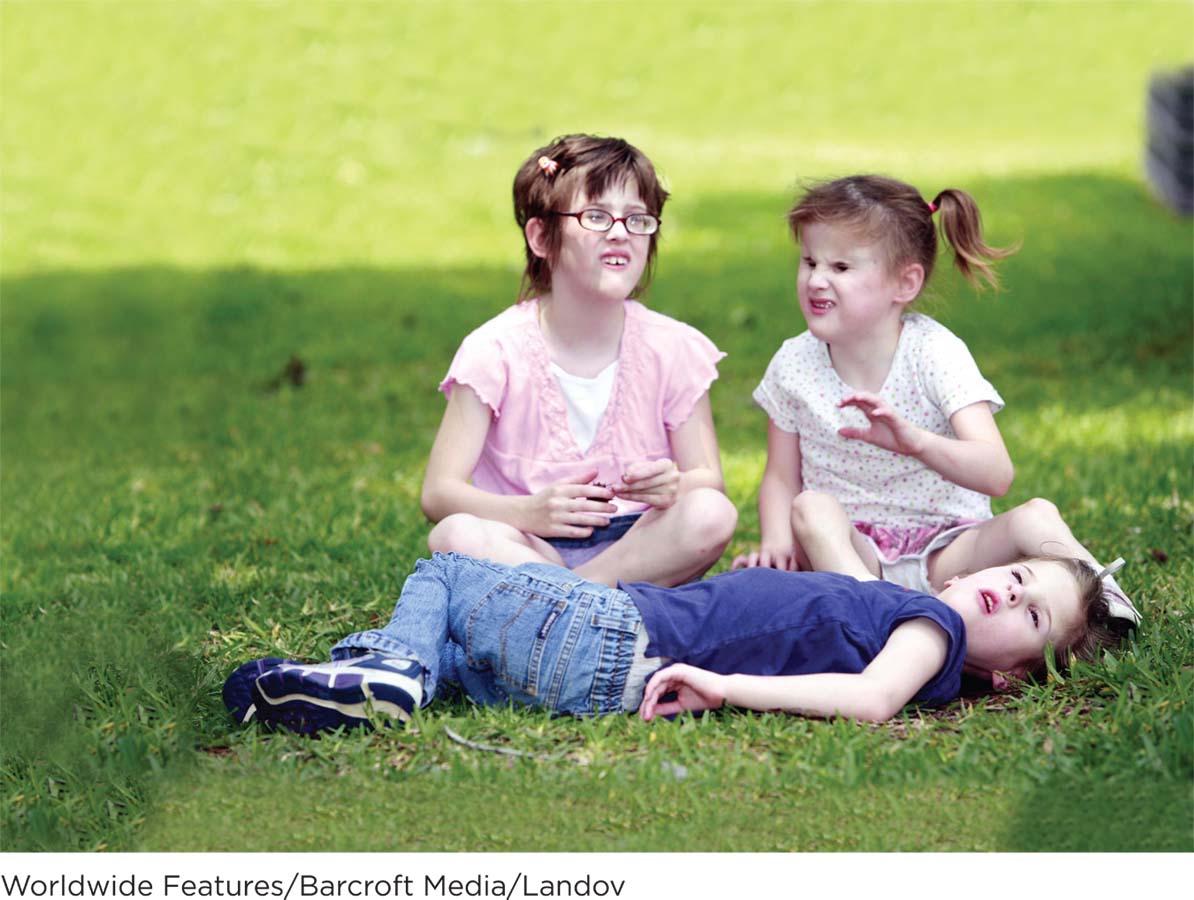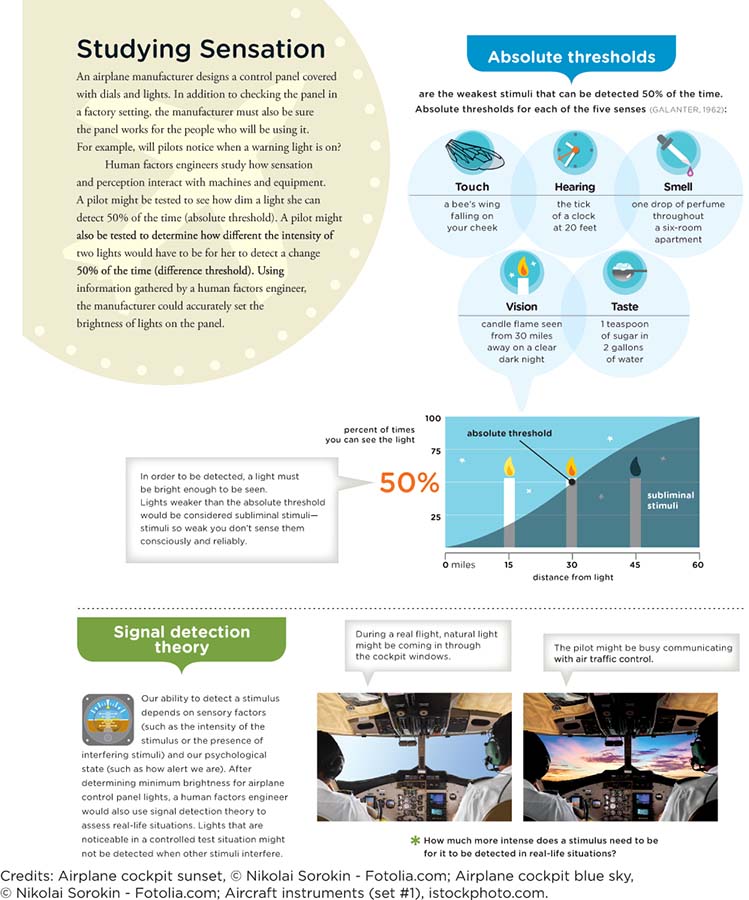3.1 An Introduction to Sensation and Perception

The Dunn sisters, Sophie (left), Zoe, and Emma (front), are the world’s only deaf and blind triplets. Emma and Zoe can see nothing, while Sophie has very limited vision even when wearing corrective lenses. All three girls wear devices known as cochlear implants, which simulate the sensation of hearing.
GOOD MORNING, TRIPLETS Long before the sun rises, Liz Allen is awake, making sure that her 13-
The floor may be sprinkled with toys if Emma has been awake in the night. She likes to climb inside her toy box and toss out everything. Zoe is a better sleeper, but she too might be up for several hours at a time. “They’re pretty active at night,” explains Liz. When sleeping, Emma and Zoe are almost certain to be found cuddled lengthwise, feet-
Gently shaking the girls, Liz says, “Wake up. Let’s get ready,” but she needn’t utter a word. She “speaks” to Emma and Zoe by moving her hands, and they “listen” by feeling her fingers dance through the motions of sign language. Emma and Zoe are completely blind and deaf. During the day, the triplets use cochlear implants, electronic devices that provide them with some degree of hearing. But these implants only provide a hearinglike experience; they do not “fix” deafness (UCSF Medical Center, 2015). The third triplet, Sophie, is easier to rouse, as she possesses some limited vision. Flipping the light switch is enough to get her started on her morning routine.
Welcome to the world of Emma, Zoe, and Sophie. They are, as far as we know, the world’s only deaf and blind triplets. 
LEARNING OBJECTIVES After reading and studying this chapter, you should be able to:
LEARNING OBJECTIVES After reading and studying this chapter, you should be able to:
LO 1 Define sensation and perception and explain how they are different.
LO 2 Define transduction and explain how it relates to sensation.
LO 3 Describe and differentiate between absolute thresholds and difference thresholds.
LO 4 Explain how electromagnetic energy is transduced into a sensation of vision.
LO 5 Describe the function of rods and cones.
LO 6 Compare and contrast the theories of color vision.
LO 7 Summarize how sound waves are transduced into the sensation of hearing.
LO 8 Illustrate how we sense different pitches of sound.
LO 9 Describe the process of olfaction.
LO 10 Discuss the structures involved in taste and describe how they work.
LO 11 Describe how the biopsychosocial perspective is used to understand pain.
LO 12 Illustrate how we sense the position and movement of our bodies.
LO 13 Identify the principles of perceptual organization.
LO 14 Identify concepts involved in depth perception.
LO 15 Define extrasensory perception and explain why psychologists dismiss claims of its legitimacy.
The Basics
LO 1 Define sensation and perception and explain how they are different.
Have you ever wondered what it is like to be blind and deaf? Most people depend on sights and sounds for virtually every daily activity, from buttering toast to answering the phone. Thanks to our eyes and ears, we can tell the difference between 12:00 noon and 12:00 midnight, soft jazz and a screaming ambulance. Sights and sounds are a source for thoughts and memories. When we think about people, we “see” their faces and “hear” their voices in our minds.

Painter David Hockney stands before his massive Bigger Trees Near Warter at an exhibition in London. Hockney reportedly has synesthesia, a rare condition whereby a person experiences a combination of perceptions in response to a “single sensory modality” (Rich & Mattingley, 2002). A synesthete may, for instance, describe the color green as having a scent, or the word “Tuesday” as being maroon with black stripes. Hockney created the stage sets for various operas by painting what he saw in the music (Ward, 2006, June 10).
How does a deaf-
Note: Quotations attributed to Liz Allen are personal communications.
sensation The process by which sensory organs in the eyes, ears, nose, mouth, skin, and other tissues receive and detect stimuli.
perception The organization and interpretation of sensory stimuli by the brain.
SENSATION VERSUS PERCEPTION The subject of this chapter is sensation and perception, the absorbing and deciphering of information from the environment. Sensation is the process by which receptors in our sensory organs (located in the eyes, ears, nose, mouth, skin, and other tissues) receive and detect stimuli. Perception is the process through which information about these stimuli is organized, interpreted, and transformed into something meaningful. Sensation is seeing a red burner on the stove; perception is thinking hot. Sensation is hearing a loud, shrill tone; perception is recognizing it as the warning sound of a fire alarm. Sensation and perception work together to provide a coherent experience of the world around and inside you. But how does this happen without your effort or awareness? How does the vast amount of stimuli outside and inside your body get transformed into experiences that seem so personal—
CONNECTIONS
In Chapter 2, we described how neurons work together to shape our experiences. The electrical signals are active within the axon, and the chemical signals are at work in the synapse.
LO 2 Define transduction and explain how it relates to sensation.
transduction The process of transforming stimuli into neural signals.
TRANSDUCTION Sensation begins when your sensory systems receive input from the environment. Each of your sensory systems is designed to respond to stimuli of a certain kind. Light waves and sound waves accost your eyes and ears, heat waves bathe your skin, molecules of different chemical compositions float into your nostrils and descend upon your taste buds, and physical objects press against your body. But none of these stimuli can have an impact on your brain unless they are translated into a language it understands: electrical and chemical signals. This is the job of the specialized sensory cells located in the back of your eyes, the caverns of your ears and nose, the spongy surface of your tongue and within your skin, muscle, and other tissues. The process of transforming stimuli into the electrical and chemical signals of neurons is called transduction, and it is the first step of sensation. The neural signals are then processed by the central nervous system, resulting in what we consciously experience as sensations (seeing a person’s face or smelling smoke).
CONNECTIONS
As discussed in Chapter 2, the brain and the spinal cord make up the central nervous system. The peripheral nervous system includes the somatic and autonomic branches of the nervous system.
For sensations to be useful, we must assign meaning to them (that face belongs to my girlfriend or the scent of smoke signals fire). And even though we describe and explain sensation and perception as two distinct events, there is no physical boundary in the brain marking the end of sensation and the beginning of perception. The processing of stimuli into sensations and perceptions is quick and automatic.
data-
knowledge-
DATA-
Synonyms
data-
knowledge-
How do these concepts figure into psychology, the scientific study of behavior and mental processes? Sensation and perception are the starting points for every psychological process you can imagine, from writing an e-
Studying Sensation

Most people are painfully aware of their new braces, but after a while they begin to notice them less. If a stimulus is ongoing and steady, we tend to become less aware of it. This process of sensory adaptation helps keep us on alert for changes in the environment.
Liz began to suspect that her triplets had vision and hearing impairments when she noticed irregularities in their behavior. When Zoe lost her hearing, for example, she became frustrated with one of her favorite toys—
HUMAN SENSATION Studying sensation means studying human beings, who are complex and variable. Not everyone is born with the same collection of stimulus-
This variability in one’s ability to sense can have profound consequences. If you get in your car immediately following a heated argument, you may be less likely to notice (that is, sense) a bicyclist in your rearview mirror—
LO 3 Describe and differentiate between absolute thresholds and difference thresholds.
absolute threshold The weakest stimuli that can be detected 50% of the time.
CONNECTIONS
In Chapter 1, we presented the evolutionary perspective. Here, it is used to explain how sensory adaptation has evolved. By ignoring unchanging stimuli, we are better prepared to detect changes in the environment. For our ancestors, picking up new information often meant the difference between life and death.
ABSOLUTE THRESHOLDS Researchers can determine various types of sensory thresholds, which are the smallest levels of stimulation people can detect. Of particular interest to psychologists are absolute thresholds, defined as the weakest stimuli that can be detected 50% of the time. The absolute threshold commonly cited for vision, for instance, is described as the equivalent of being able to see the flame of one candle, in the dark of night, 30 miles away 50% of the time (Galanter, 1962). But, remember, the state of a person’s body and mind can influence his ability to sense a faint stimulus: Although absolute thresholds have been established for the general population (Infographic 3.1; Galanter, 1962), these thresholds are not necessarily absolute for a particular person over time. Absolute thresholds are important, but there is more to sensation than noting the presence of a stimulus. Many everyday sensory experiences involve detecting changes in environmental stimuli.
sensory adaptation Sensory receptors tend to become less sensitive to constant stimuli.
SENSORY ADAPTATION Have you ever put on cologne or perfume and wondered if it was too strong, but within a matter of minutes you don’t even notice it? Or perhaps you have jumped into an ice-
difference threshold The minimum difference between two stimuli that can be noticed 50% of the time.
DIFFERENCE THRESHOLDS Intrigued by this keen sensitivity to change, early psychologists decided to figure out how different stimuli need to be in order for someone to notice their difference. Through careful experimentation, they established various difference thresholds, or the minimum differences between two stimuli noticed 50% of the time.
Synonyms
difference thresholds just noticeable differences
Let’s say you are blindfolded, holding a 100-
INFOGRAPHIC 3.1

Weber’s law The law stating that each of the five senses has its own constant ratio determining difference thresholds.

Participants from China and the Netherlands were asked to choose the less colorful image. Can you tell there’s a difference in brightness? The difference threshold, or just noticeable difference, is the minimum difference between two stimuli noticed 50% of the time.
According to Ernst Heinrich Weber (1795–
CONNECTIONS
In Chapter 1, we presented the sociocultural perspective, which helps us understand how some behaviors differ across cultures, and others are universal. Here, we see how difference thresholds are the same across cultures.
Difference thresholds vary slightly from person to person because each of us has a unique sensory toolkit. But is there variation across people from different cultures? In one study, researchers compared participants’ ability to detect changes to pictures (for example, their brightness and color) of flowers, balloons, rabbits, and other objects (see photo above). The just noticeable difference was the same for the Chinese and Dutch participants “for most images” (Qin et al., 2010, p. 25). The implication is that this aspect of sensation and perception might not be influenced by cultural factors.
Apply This
You Are in Control: Subliminal Influences
CONNECTIONS
In Chapter 1, we discussed critical thinking and psychomythology. The claim that subliminal advertising can make us buy things we don’t want is an example of this type of “misinformation” about human behavior. An important component of critical thinking is determining if there is scientific evidence to support or refute claims, including those conveyed in urban myths.
The absolute thresholds and difference thresholds discussed above pertain to stimuli that we can detect at least 50% of the time. What about stimuli below these thresholds? Do subliminal stimuli, which are well below our absolute thresholds (such as light that is too dim to see and sounds that are too faint to hear), have an impact on us? Perhaps you have heard of “subliminal advertising,” or stealthy attempts by marketers to woo you into buying their products. Here’s an example: You’re in a theater and suddenly the words “Buy Popcorn!” flash across the screen, but only for a few milliseconds. Your sensory receptors may detect this fleeting stimulus, but so briefly that you don’t notice. According to urban myth, subliminal marketing can make you run out and buy popcorn, soft drinks, or whatever products happen to be advertised. But these messages cannot affect behavior in this way. They cannot manipulate you to purchase something you had not planned on purchasing, or to quit smoking, for example (Karremans, Stroebe, & Claus, 2006). Remember, you have conscious authority over the purchases and life choices you make. 
That being said, the brain does register information presented at an unconscious or nonconscious level. Neuroimaging studies suggest that neural activity is evident in response to the “subliminal presentation” of stimuli (Axelrod, Bar, Rees, & Yovel, 2014; Kouider & Dehaene, 2007). These subliminal messages may be able to influence fleeting moods through priming (stimulating memories beneath awareness through previous exposure; Chapter 6). One study found that if you expose people to ugly scenes (for example, pictures of dead bodies or buckets of snakes) for several milliseconds (thus “priming” them), they then will rate a neutral picture of a woman’s face as less likable than when exposed to feel-
Thus far, we have focused on the stimulus itself. But what about other environmental factors, such as background stimuli competing for the observer’s attention, or internal factors like the observer’s state of mind—
signal detection theory A theory explaining how various factors influence our ability to detect weak signals in the environment.
SIGNAL DETECTION THEORY As previously noted, our ability to detect weak stimuli in the environment is based on many factors, and the theory that draws them all together is called signal detection theory (Infographic 3.1). It is based on the idea that “noise” from our internal and external environments can interfere with our ability to detect weak signals. Imagine you are participating in an experiment studying the detection of weak stimuli, and you are told to push a button when you see a light flash. The strength of the flashes will range from clearly noticeable to undetectable. You sometimes press the button, but it turns out no light flash occurred: a false alarm. Other times you will press the button and be correct: a hit. How many hits and false alarms you have depends on many internal factors, including how tired you are, when you last ate, your expectations about the importance of success, your motivation, and so on. It also depends on external variables, such as the light level in the room and the dust in the air.
Signal detection theory is useful in a variety of real-
In situations like this, the ability to sense and perceive may have life or death implications. But how exactly does each of the five senses collect and process information? Let’s start by exploring the sense that is generally considered most dominant: vision.
show what you know
Question 1
1. ____________ makes the information received by the sensory receptors more meaningful by drawing from experience to organize and interpret sensory data.
Perception
Transduction
Sensation
Signal detection
a. Perception
Question 2
2. Transduction is the process of transforming stimuli into neural signals. Identify some stimuli in your current surroundings that are being transformed into neural signals you experience as sensations.
Answers will vary. Some examples may include the light reflecting off the book, the vibration of your phone, the sound of your refrigerator.
Question 3
3. A woman standing next to you at the supermarket has some very strong-
sensation.
transduction.
perception.
sensory adaptation.
d. sensory adaptation.